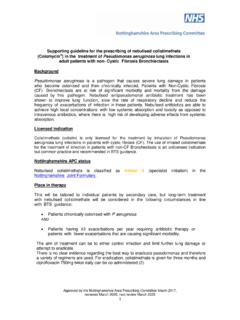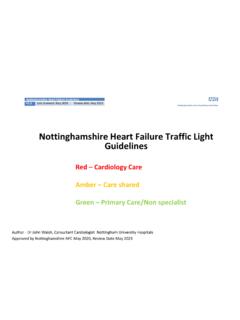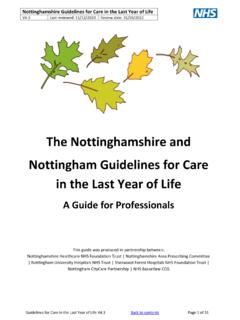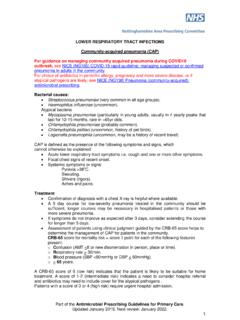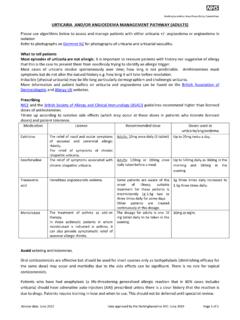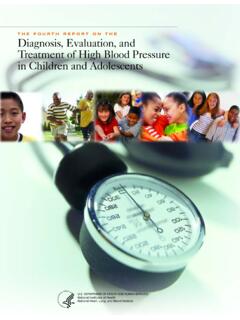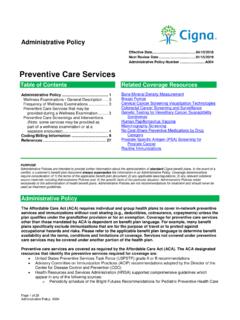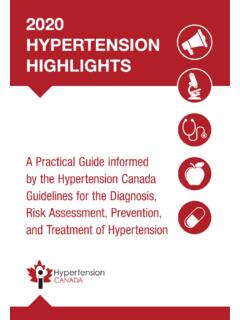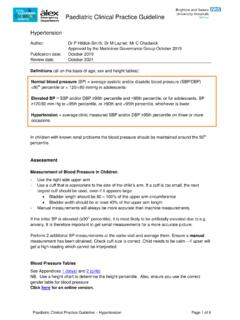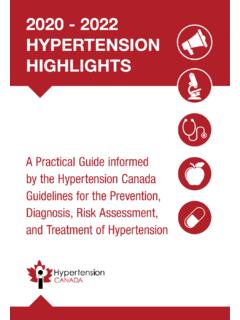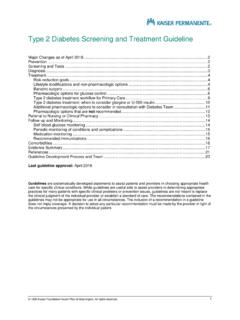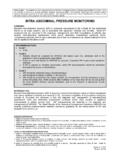Transcription of Blood Pressure and Heart Rate Monitoring in Children
1 Blood Pressure and Heart Rate Monitoring in Children Last reviewed: 17/09/2020 Review date: 17/09/2023 Blood Pressure and Heart Rate Monitoring in Children Information Sheet for Primary Care Prescribers I. Blood Pressure Manual Blood Pressure measurement using a sphygmomanometer is the gold standard in Children , with direct arterial BP measuring in neonates. Blood Pressure may be measured using an automated oscillometric device or a manual cuff and auscultation. Oscillometric devices may overestimate Blood Pressure so any high Blood Pressure measured this way should be checked manually.
2 There are a number of basic principles that should be adhered to regardless of method used to measure. Action Rationale Whenever possible the child should be rested for 3 minutes before each measurement. Activity elevates Heart rate and Blood Pressure and will lead to inaccurate reading. Ensure the child is comfortable, with the limb used for measurement resting at Heart level. If the child is uncomfortable it can increase Heart rate and Blood Pressure , and will lead to an inaccurate reading. The bladder in the cuff used should encircle 80-100% of the limb circumference (this is often indicated by a range guide on the cuff itself).
3 The widest cuff available should be used. A selection of cuffs must be available. A cuff that is too small will give a false high reading, and a cuff that is too large will give a false low. When possible the same limb, cuff and method of measurement should be used each time. Therefore it is important for this information to be clearly documented. For Blood Pressure readings to be comparable with each other the same method and equipment is needed. Always leave at least one minute between each reading. This enables the child to settle and become calm, to promote the accuracy of the reading.
4 Normal Blood Pressure readings for Children Children s Blood Pressure increases with size. The most accurate way of measuring Blood Pressure is comparing readings based upon the child s height, using the normal growth charts to determine the child s percentile (See appendix 1). A child would be considered to be normotensive if their Blood Pressure is at the 90th percentile or less. Table 1: Definitions of BP Categories and Stages Blood Pressure and Heart rate Monitoring in Children Author: Shary Walker Specialist Interface and Formulary Pharmacist Review date: September 2023 2 Table 2: Management Asymptomatic hypertension: Average SBP 95th to 95th + 12mmHg, or for Children aged 13 and over, 130/80 to 139/89 systolic Investigate and lifestyle advice.
5 Treat as per hypertension guideline in paediatric patients. Recheck the BP in 1 to 2 weeks by auscultation (manual). If still at the stage 1 HTN level, upper and lower extremity BP should be checked (right arm, left arm and 1 leg) and BP should be rechecked in 3 months. Refer as appropriate. Symptomatic hypertension and/or acute severe hypertension: Average SBP of 95th centile + 12mmHg or 140/90 (whichever is lowest) Refer for hospital admission. Refer to paediatric hypertension specialist if Blood Pressure is consistently above the 95th centile of age and height.
6 Hypertensive crisis: seizures, encephalopathy or cardiac failure Require admission to an HDU or PICU setting Table 3: Blood Pressure measurement using an automated monitor Action Rationale 1. Place the appropriate cuff on the child s limb, ensuring artery indicator is placed over the artery to be used for the measurement. To ensure an accurate reading is obtained. The right arm should be used whenever possible. However, if this limb is injured or has a cannula in situ it should not be used. 2. Switch on machine, and if possible set for 30mmHg above expected systolic Pressure . This can be changed on many models.
7 This will increase the accuracy of the reading, enabling the machine to detect the oscillations in Pressure accurately. 3. Press the machine to start, ensuring that the child is comfortable and the limb is supported. 4. Remove cuff To make the child comfortable 5. Readings should be recorded accurately to 2mmHg, not rounded to the nearest value. Rounding off to the nearest 5-10mmHg can result in an inaccurate reading affecting treatment decisions. II. Heart Rate Reference ranges for Heart rate in Children is summarised here. Management of Heart rate above 180 bpm in Children can be found on Supraventricular Tachycardia guideline.
8 References: 1. Flynn JT, et al. Clinical Practice Guideline for Screening and Management of high Blood Pressure in Children and Adolescents. Pediatrics. 2017;140(3):e20171904 2. Great Ormond Street Hospital for Children . Appendix 4 Normal Heart Rates. 2020. [Online]. Accessed on 12/08/2020. 3. Josep Brugada, , Pharmacological and non-pharmacological therapy for arrhythmias in the pediatric population: EHRA and AEPC-Arrhythmia Working Group joint consensus statement, EP Europace, Volume 15, Issue 9, September 2013, Pages 1337 1382, 4. National high Blood Pressure Education Program Working Group on high Blood Pressure in Children and Adolescents.
9 The fourth report on the diagnosis , evaluation , and treatment of high Blood Pressure in Children and adolescents. Pediatrics. 2004;114(2 Suppl 4th Report):555-576. 5. Nottingham University Hospitals. Guideline for the assessment and management of Hypertension in Paediatric Patients. August 2020. 6. Nottingham University Hospitals. Guideline for the Management of Supraventricular Tachycardia in Children and Young People. June 2020. 7. Royal College of Nursing. Standards for Assessing, Measuring and Monitoring Vital Signs in Infants, Children and Young People. Royal College of Nursing, London.
10 May 2020. [Online]. Accessed on 12/08/2020. Blood Pressure and Heart rate Monitoring in Children Author: Shary Walker Specialist Interface and Formulary Pharmacist Review date: September 2023 3 Appendix 1: Blood Pressure centiles by gender, age and height centile Table 1. BP Levels for Boys by Age and Height Percentile Age (y) BP Percentile SBP (mm Hg) DBP (mm Hg) Height Percentile or Measured Height Height Percentile or Measured Height 5th 10th 25th 50th 75th 90th 95th 5th 10th 25th 50th 75th 90th 95th 1 50th 85 85 86 86 87 88 88 40 40 40 41 41 42 42 90th 98 99 99 100 100 101 101 52 52 53 53 54 54 54 95th 102 102 103 103 104 105 105 54 54 55 55 56 57 57 95th + 12 mmHg 114 114 115 115 116 117 117 66 66 67 67 68 69 69 2 50th 87 87 88 89 89 90 91 43 43 44 44 45 46 46 90th 100 100 101 102 103 103 104 55 55 56 56 57 58 58 95th 104 105 105 106 107 107 108 57 58 58 59 60 61 61 95th + 12 mmHg 116 117 117 118 119 119 120 69 70 70 71 72 73 73 3 50th 88 89 89 90 91 92
